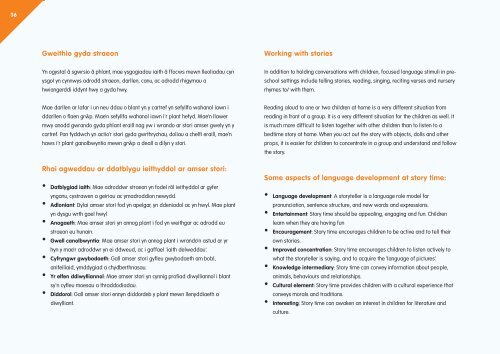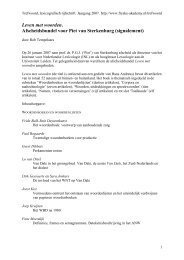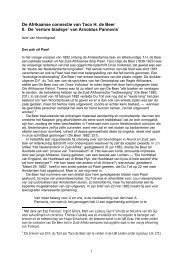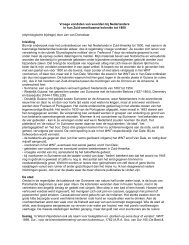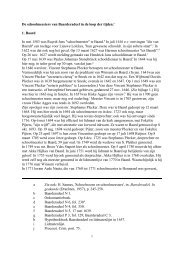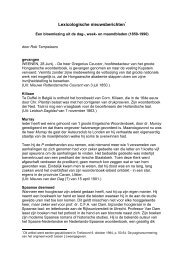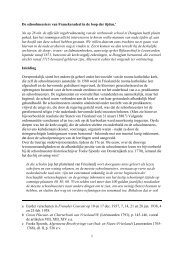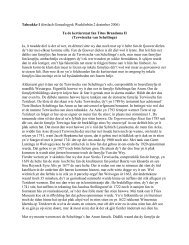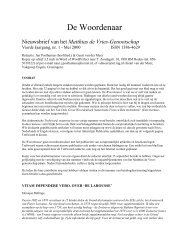language - Fryske Akademy
language - Fryske Akademy
language - Fryske Akademy
Create successful ePaper yourself
Turn your PDF publications into a flip-book with our unique Google optimized e-Paper software.
36<br />
Gweithio gyda straeon<br />
Yn ogystal â sgwrsio â phlant, mae ysgogiadau iaith â ffocws mewn lleoliadau cyn<br />
ysgol yn cynnwys adrodd straeon, darllen, canu, ac adrodd rhigymau a<br />
hwiangerddi iddynt hwy a gyda hwy.<br />
Mae darllen ar lafar i un neu ddau o blant yn y cartref yn sefyllfa wahanol iawn i<br />
ddarllen o flaen grŵp. Mae'n sefyllfa wahanol iawn i'r plant hefyd. Mae'n llawer<br />
mwy anodd gwrando gyda phlant eraill nag yw i wrando ar stori amser gwely yn y<br />
cartref. Pan fyddwch yn actio'r stori gyda gwrthrychau, doliau a chelfi eraill, mae'n<br />
haws i'r plant ganolbwyntio mewn grŵp a deall a dilyn y stori.<br />
Rhai agweddau ar ddatblygu ieithyddol ar amser stori:<br />
• Datblygiad iaith: Mae adroddwr straeon yn fodel rôl ieithyddol ar gyfer<br />
ynganu, cystrawen a geiriau ac ymadroddion newydd.<br />
• Adloniant: Dylai amser stori fod yn apelgar, yn ddeniadol ac yn hwyl. Mae plant<br />
yn dysgu wrth gael hwyl<br />
• Anogaeth: Mae amser stori yn annog plant i fod yn weithgar ac adrodd eu<br />
straeon eu hunain.<br />
• Gwell canolbwyntio: Mae amser stori yn annog plant i wrando'n astud ar yr<br />
hyn y mae'r adroddwr yn ei ddweud, ac i gaffael 'iaith delweddau'.<br />
• Cyfryngwr gwybodaeth: Gall amser stori gyfleu gwybodaeth am bobl,<br />
anifeiliaid, ymddygiad a chydberthnasau.<br />
• Yr elfen ddiwylliannol: Mae amser stori yn cynnig profiad diwylliannol i blant<br />
sy'n cyfleu moesau a thraddodiadau.<br />
• Diddorol: Gall amser stori ennyn diddordeb y plant mewn llenyddiaeth a<br />
diwylliant.<br />
Working with stories<br />
In addition to holding conversations with children, focused <strong>language</strong> stimuli in preschool<br />
settings include telling stories, reading, singing, reciting verses and nursery<br />
rhymes to/ with them.<br />
Reading aloud to one or two children at home is a very different situation from<br />
reading in front of a group. It is a very different situation for the children as well. It<br />
is much more difficult to listen together with other children than to listen to a<br />
bedtime story at home. When you act out the story with objects, dolls and other<br />
props, it is easier for children to concentrate in a group and understand and follow<br />
the story.<br />
Some aspects of <strong>language</strong> development at story time:<br />
• Language development: A storyteller is a <strong>language</strong> role model for<br />
pronunciation, sentence structure, and new words and expressions.<br />
• Entertainment: Story time should be appealing, engaging and fun. Children<br />
learn when they are having fun<br />
• Encouragement: Story time encourages children to be active and to tell their<br />
own stories.<br />
• Improved concentration: Story time encourages children to listen actively to<br />
what the storyteller is saying, and to acquire the ‘<strong>language</strong> of pictures’.<br />
• Knowledge intermediary: Story time can convey information about people,<br />
animals, behaviours and relationships.<br />
• Cultural element: Story time provides children with a cultural experience that<br />
conveys morals and traditions.<br />
• Interesting: Story time can awaken an interest in children for literature and<br />
culture.


